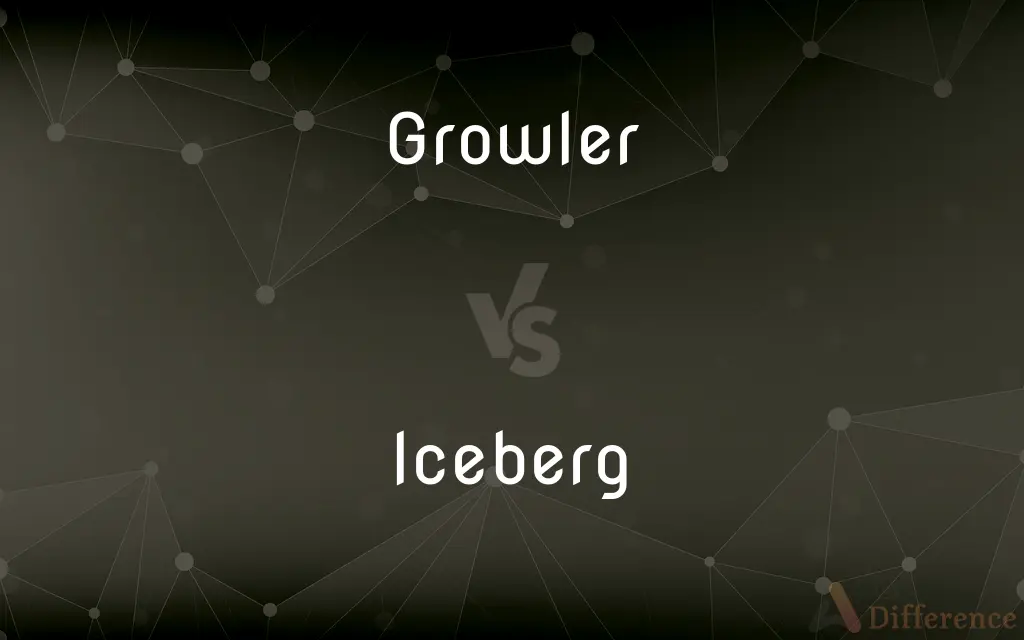Growler vs. Iceberg — What's the Difference?
By Urooj Arif & Fiza Rafique — Updated on April 16, 2024
A growler is a small iceberg with less than 5 meters showing above water, often hazardous to ships; whereas, an iceberg is a large piece of freshwater ice that has broken off a glacier or an ice shelf.

Difference Between Growler and Iceberg
Table of Contents
ADVERTISEMENT
Key Differences
A growler is a type of iceberg, much smaller in size, typically showing less than 5 meters above water level. This small size makes it difficult to detect but potentially hazardous to ships, especially in foggy conditions. On the other hand, an iceberg is a massive piece of freshwater ice that has calved from glaciers or ice shelves, visible above the sea surface and can vary greatly in size, often towering many meters above the water and extending deep underwater.
Growlers are generally the result of larger icebergs breaking down into smaller pieces; they can be as small as a grand piano. This makes them particularly dangerous for maritime navigation due to their low profile in the water. In contrast, icebergs, due to their substantial size, are usually detectable by radar and other navigation systems, posing a different set of challenges and threats.
The term "growler" comes from the growling noise these small icebergs make when they rub against each other in the water. Whereas, the term "iceberg" is derived from the Dutch word "ijsberg," which literally means "ice mountain," aptly describing their often monumental appearance.
Growlers, being smaller, tend to melt faster and are more influenced by waves and wind, making their movements unpredictable. Icebergs, with their massive bulk, are more influenced by ocean currents than by wind, and their melting process is considerably slower due to their larger size.
While both growlers and icebergs originate from the same process of calving from larger ice formations, growlers are typically found closer to their parent icebergs and in colder waters. Icebergs can travel thousands of kilometers, carried by ocean currents, sometimes reaching warmer waters and posing navigational hazards even far from polar regions.
ADVERTISEMENT
Comparison Chart
Size Above Water
Less than 5 meters visible
Can be over 100 meters visible
Origin
Breakdown of larger icebergs
Calved from glaciers or ice shelves
Navigational Hazard
Difficult to detect, hazardous to small boats
Visible but can pose threats to all vessels
Influence by Nature
More affected by waves and wind
Primarily influenced by ocean currents
Melting Rate
Faster due to smaller size
Slower due to larger mass
Compare with Definitions
Growler
Noise-making floating ice.
The growlers made a continuous growling noise as they collided with each other.
Iceberg
Ice structure predominantly underwater.
Most of the iceberg's mass is hidden underwater, which poses great risks.
Growler
A piece of ice showing less than two meters above the water.
The growler bobbed up and down with the waves, barely noticeable.
Iceberg
A large mass of ice floating in open waters.
The Titanic tragically sank after hitting a massive iceberg.
Growler
A small iceberg or fragment of ice.
The ship had to navigate carefully through the waters filled with growlers.
Iceberg
Ocean-bound ice giant.
The iceberg drifted slowly across the ocean, a stark reminder of nature’s power.
Growler
Minor ice remnants from larger icebergs.
As the iceberg melted, several growlers broke off and floated away.
Iceberg
Freshwater ice originating from glaciers.
That iceberg likely calved from the glacier we saw earlier.
Growler
Floating ice hazard of smaller size.
Growlers can be nearly invisible to radar, complicating navigation.
Iceberg
Glacier-derived large ice form.
Icebergs often calve during the spring thaw, becoming hazards in shipping lanes.
Growler
One, such as a dog, that growls.
Iceberg
An iceberg is a large piece of freshwater ice that has broken off a glacier or an ice shelf and is floating freely in open (salt) water. Small bits of disintegrating icebergs are called "growlers" or "bergy bits".Icebergs calved by glaciers that face the open sea, such as in Greenland, are irregular shaped piles.
Growler
A small iceberg.
Iceberg
A large floating mass of ice detached from a glacier or ice sheet and carried out to sea.
Growler
(Electricity) An electromagnetic device with two poles, used for magnetizing, demagnetizing, and finding short-circuited coils.
Iceberg
A massive floating body of ice broken away from a glacier. Only about 10 percent of its mass is above the surface of the water.
Growler
A container used for carrying draft beer, especially a half-gallon or gallon glass jug with a gasket or screw cap.
Iceberg
(Informal) A cold, aloof person.
Growler
A person, creature or thing that growls.
Iceberg
(obsolete) The seaward end of a glacier. 19
Growler
A horse-drawn cab with four wheels.
Iceberg
A huge mass of ocean-floating ice which has broken off a glacier or ice shelf 19
The Titanic hit an iceberg and sank.
Growler
A small iceberg or ice floe which is barely visible over the surface of the water.
Iceberg
An aloof person. 19
Growler
A kind of jug used to carry beer (in current usage, a 2-liter or 64-ounce container with or without a handle; sometimes extended to similarly shaped 32-ounce jug, but not bottles).
Iceberg
An impending disastrous event whose adverse effects are only beginning to show, in reference to one-tenth of the volume of an iceberg being visible above water.
Growler
A pork pie.
Iceberg
A large mass of ice, generally floating in the ocean.
Growler
The vulva.
Iceberg
A large mass of ice floating at sea; usually broken off of a polar glacier
Growler
A fish of the perch family, abundant in North American rivers, so named from the sound it emits.
Iceberg
Lettuce with crisp tightly packed light-green leaves in a firm head;
Iceberg is still the most popular lettuce
Growler
A device for checking electrical equipment for short circuits etc.
Growler
One who growls.
Growler
The large-mouthed black bass.
Growler
A four-wheeled cab.
Growler
A speaker whose voice sounds like a growl
Growler
A small iceberg or ice floe just large enough to be hazardous for shipping
Common Curiosities
What causes growlers and icebergs to form?
Both growlers and icebergs form through a process called calving, where chunks of ice break off from glaciers or larger ice shelves.
How are growlers and icebergs tracked?
Icebergs are tracked via satellite and aerial surveillance due to their size, whereas growlers are harder to monitor and often require closer, more precise navigation tools.
Do growlers pose a risk to wildlife?
Growlers can pose risks to marine wildlife, particularly in crowded or biodiverse habitats, by altering natural behaviors or causing physical harm.
How long do growlers and icebergs last?
Growlers generally melt quicker due to their smaller size, whereas icebergs, being larger, can last for years depending on environmental conditions.
Can the age of an iceberg be determined?
Yes, scientists can estimate the age of an iceberg by analyzing its structure, layering, and sometimes by tracing its origin back to a specific glacier.
What is the ecological impact of growlers and icebergs?
Icebergs and growlers contribute to ocean freshwater distribution, influence sea levels, and can impact marine ecosystems and ocean currents.
What happens when a growler or iceberg melts completely?
When they melt, growlers and icebergs release freshwater into the saltwater ocean, which can affect local salinity, water temperatures, and marine currents.
Are growlers or icebergs affected by climate change?
Yes, both are affected by climate change; warmer global temperatures lead to faster melting and increased calving rates from ice shelves.
How are icebergs and growlers formed differently?
While both are products of calving, growlers specifically refer to the smaller pieces that break off from an already existing iceberg.
How do changes in ocean currents affect growlers and icebergs?
Changes in ocean currents can significantly alter the travel paths and melting rates of both growlers and icebergs, impacting their lifespan and distribution.
What type of ships are most at risk from growlers?
Smaller vessels and those without advanced ice-detection technology are most at risk from growlers due to their low visibility and potential for sudden appearance.
What are the visual differences between growlers and icebergs?
Icebergs are typically much larger and more visible above the water's surface, often appearing as towering ice mountains, whereas growlers are smaller, lower in the water, and less conspicuous.
Can both growlers and icebergs be found in all polar regions?
Yes, both can be found in Arctic and Antarctic waters, wherever there are suitable glaciers and ice shelves.
Are growlers ever larger than icebergs?
No, by definition, growlers are smaller fragments of ice; any larger piece of ice that breaks off from a glacier or ice shelf is categorized as an iceberg.
What safety measures do ships take to navigate through waters containing growlers and icebergs?
Ships use radar, sonar, and sometimes satellite imagery to detect these ice hazards, along with adhering to known safe routes and receiving updates from ice patrol services.
Share Your Discovery

Previous Comparison
Pore vs. Sore
Next Comparison
Excellence vs. MediocrityAuthor Spotlight
Written by
Urooj ArifUrooj is a skilled content writer at Ask Difference, known for her exceptional ability to simplify complex topics into engaging and informative content. With a passion for research and a flair for clear, concise writing, she consistently delivers articles that resonate with our diverse audience.
Co-written by
Fiza RafiqueFiza Rafique is a skilled content writer at AskDifference.com, where she meticulously refines and enhances written pieces. Drawing from her vast editorial expertise, Fiza ensures clarity, accuracy, and precision in every article. Passionate about language, she continually seeks to elevate the quality of content for readers worldwide.















































